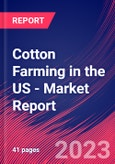Closet staple: The number of new entrants will slow as subsidies decline
The Cotton Farming industry has experienced extremely volatile operating conditions over the past five years. COVID-19 caused states and localities to enact quarantines, reducing consumer spending and demand for products made by textile mills and clothing manufacturers. Since these industries are critical cotton buyers, the pandemic caused industry revenue to decline. Plunging cotton prices worsened the industry's performance, as they reduced the value of sales. Surging commodity prices immediately following the pandemic contributed to a partial resurgence, but they also made substitutes more attractive. Trade wars and an appreciating dollar caused exports to fall. Since exports constitute a significant source of revenue for cotton farmers, their poor performance negatively impacted operators. As interest rates have risen recently, cotton farmers have held off on purchasing better machines, hindering crop yields. Overall, revenue for cotton farmers is forecast to creep downward at a CAGR of 0.9% to $8.6 billion over the five years to 2023, including a 2.9% decline in 2023 alone.
Farms in this industry primarily grow cotton, which is typically used in textile manufacturing, while the plant’s cottonseed is exploited for its oil and used in some livestock feeds. Much of the cotton produced domestically is exported.
This report covers the scope, size, disposition and growth of the industry including the key sensitivities and success factors. Also included are five year industry forecasts, growth rates and an analysis of the industry's key players and their market shares.
Methodology

LOADING...








